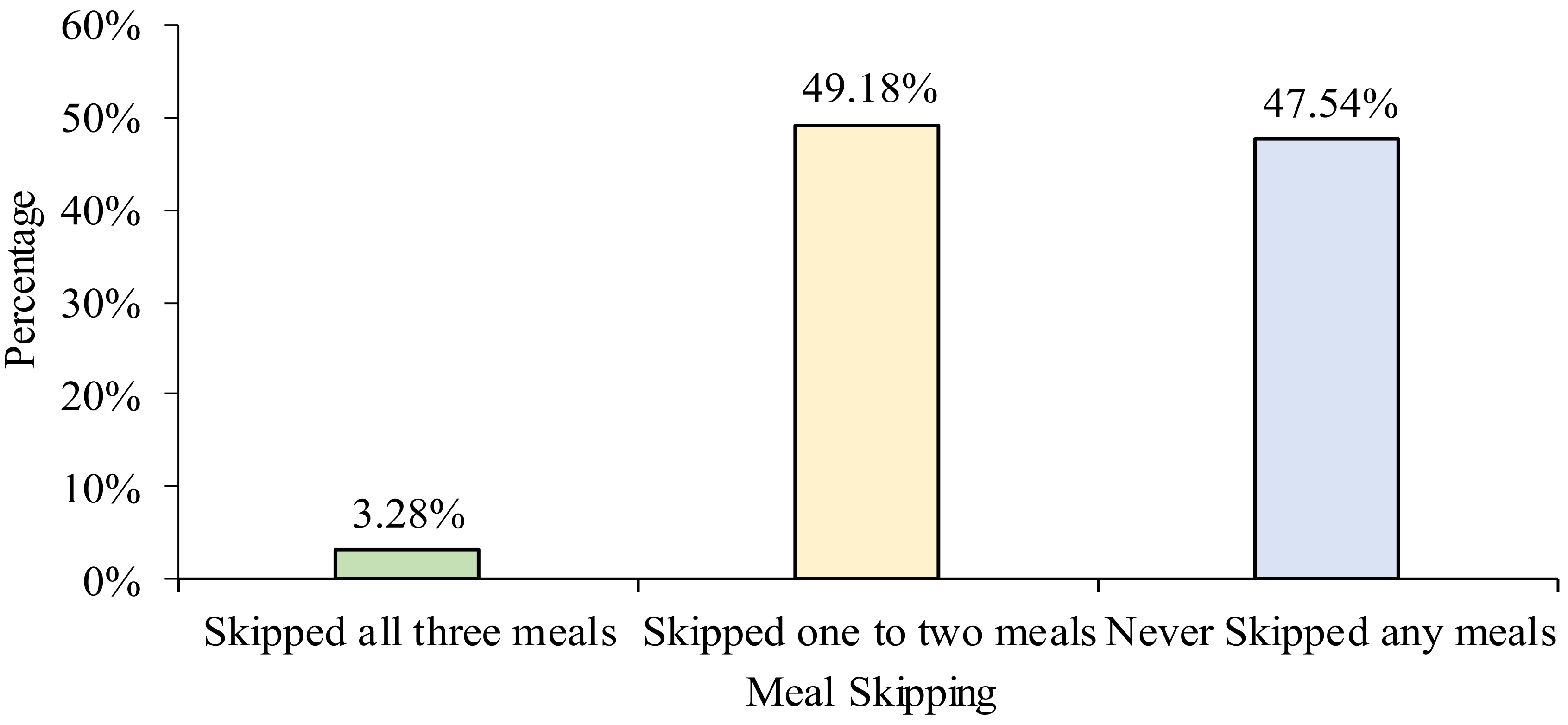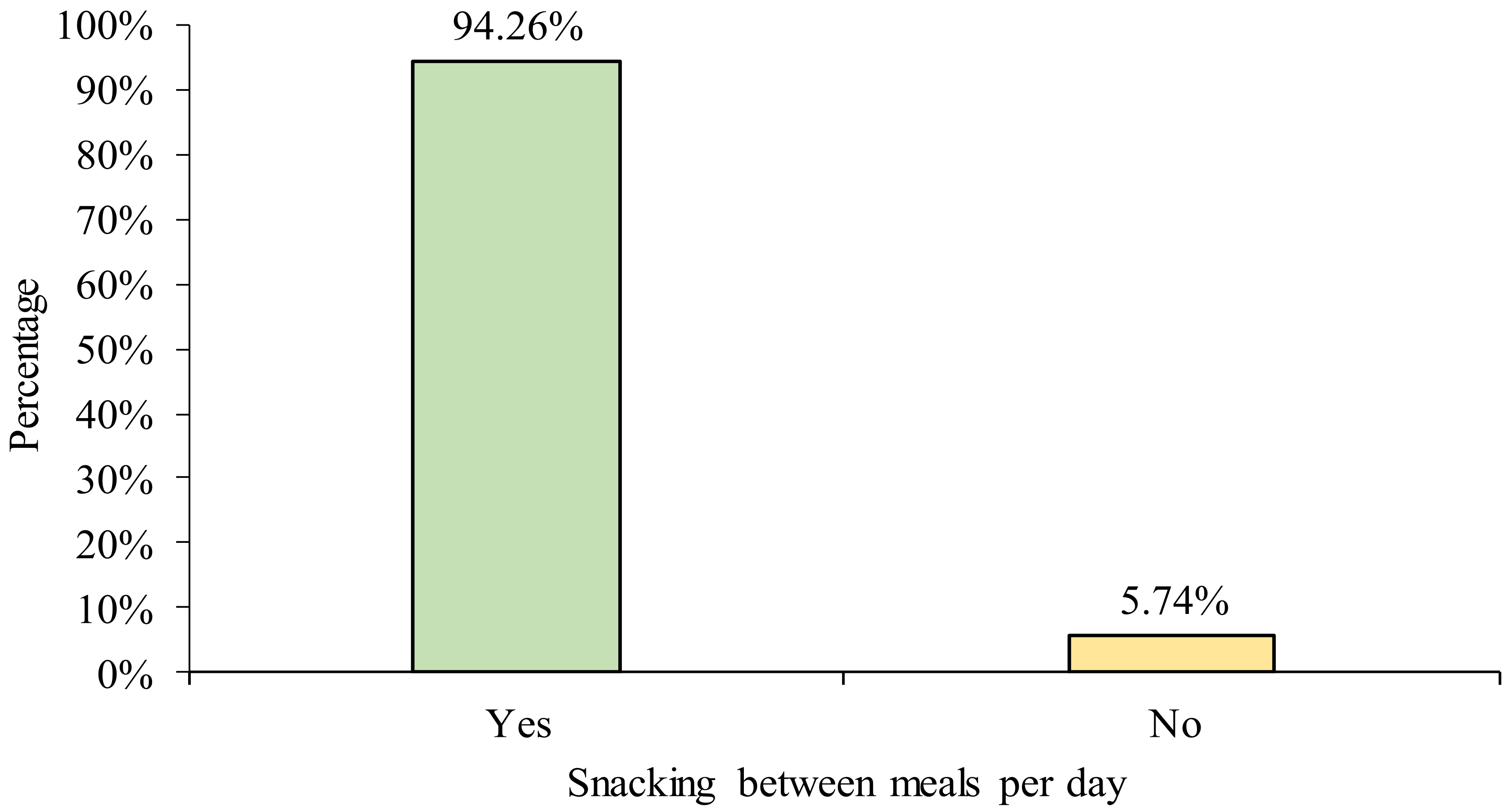1. Introduction
Coronavirus Disease-2019 (COVID-19) is caused by a virus known as severe acute respiratory syndrome coronavirus 2 (SARS-CoV-2). It was first discovered in Wuhan, China in December 2019 and declared as a pandemic by World Health Organization (WHO) in March 2020 [
1]. This pandemic had led to 5,127,696 death cases globally and 29,892 death cases in Malaysia as of 19 November 2021 [
2]. In view of the rising number of active and death cases, the government of Malaysia ordered the closure of universities, cancellation of all physical classes, and transition to online learning mode under the Movement Control Order (MCO). This is because the SARS-CoV-2 virus can be easily transmitted when the infected person coughs or sneezes. To prevent the spread of the virus by practicing physical distancing, the Malaysian education system implemented online teaching and learning.
Eating behavior is a widely used term that includes preferences of food and intentions, eating habits, dieting, and problems that are related to eating, such as feeding disorders, eating disorders, and underweight or overweight [
3], while meal skipping is defined as the omission of one or more main meals throughout the day [
4]. Young adults aged 18–30 years in the period of transition and development might possess higher rates of meal skipping [
4].
The study of Gan et al. [
5] showed that the majority of the Malaysian undergraduates skipped at least one meal daily in the past seven days. Common reasons for meal skipping were reported to be insufficient time, price of food, and weight maintenance [
4]. Another study conducted in Malaysia revealed that most undergraduates (73.5%) from medical science have low consumption of fruits, i.e., not more than three times in a week, and 51.5% of them consumed fried food for the frequency of twice or more a week [
6]. According to Gallo et al. [
7], the energy intake by female university students during the COVID-19 pandemic was 20% greater than the usual intake. This study even showed a rise in the snacking frequency during this COVID-19 pandemic, especially in individuals with a BMI higher than the normal range [
8].
The teaching and learning in Malaysia’s education system changed from face-to-face to online mode since the COVID-19 outbreak in March 2020. A recent study reported that eating behaviors during home confinement was unhealthier [
9,
10]. Currently, there are few studies available that examined the eating behaviors among online learning undergraduates during the COVID-19 pandemic in Malaysia. Hence, this study aimed to determine the eating behaviors among online learning undergraduates during the COVID-19 pandemic.
2. Material and Methods
This cross-sectional study was conducted using a questionnaire created through Google Forms. Data collection was carried out in the period of 20 January 2021 to 25 February 2021 using a convenience sampling approach. Online platforms (Microsoft Teams, email, and WhatsApp) were utilized to circulate the questionnaire to the online learning undergraduates studied in a private university in Kampar, Perak, Malaysia. The sample size was calculated using Cochran’s formula with a prevalence rate of 6% (Prevalence of university students with abnormal eating behaviors reported by Abdalla et al. [
11]), a normal deviation at 95% confidence interval, and ±5% error of precision. After adjusting 10% of the non-response rate, the minimum sample size required was 96; a total of 122 respondents who met the inclusion criteria of being Malaysian, undergraduate, multi-racial, and multi-ethnic were recruited. The exclusion criteria were postgraduate, on medication, and the presence of systematic disease. Approval from this study was obtained from Universiti Tunku Abdul Rahman Scientific and Ethical Review Committee with the ethical code Re: U/SERC/23/2021.
2.1. Assessment of Eating Behaviors
An online questionnaire consisting of informed consent, sociodemographic information, and Eating Behaviors Questionnaires (EBQ) was used. Respondents who gave consent to voluntarily participate in the present study would select the ‘Agree’ option and would then be directed to complete the online questionnaire. In the sociodemographic segment, questions on gender, ethnicity, age, current living arrangement, academic year, height (centimeter), and weight (kilograms) were gathered. Respondents were required to self-report their weight and height. The nutritional status of the respondents was estimated using the body mass index (BMI) according to the cut-off points of WHO standards [
12]. The EBQ was a validated instrument developed by Chin and Nasir [
13] to assess eating behaviors. This questionnaire consisted of questions on assessing the frequency of meal intake, frequency of snack intake between meals, types of snack foods and beverages intake, frequency of eating away from home, use of health supplements, dietary practices, and participation in weight control programs. The questionnaire of this study is accessible upon email request to the corresponding author.
2.2. Statistical Analysis
IBM SPSS Statistics 26 (IBM Corp, Armonk, NY, USA) was used to analyze the data. Descriptive statistics such as mean, standard deviation (SD), frequency, and percentage were used to describe all variables. Chi-squared test of independence was used to estimate associations between sociodemographic variables (gender, age, current living arrangement, academic year, and BMI) and meal skipping behavior. The statistical significance was set at p < 0.05.
4. Discussion
This study demonstrated that majority of the online learning undergraduates had normal BMI (>50%) and the proportion of respondents with underweight (27%) were found to be higher than overweight and obese (14%) students. These results were similar to previous studies done during the non-COVID-19 period [
14,
15]. According to Ren et al. [
16], the increasing trend of underweight among university students might be due to insufficient nutrient intake as a result of poor eating behavior.
Globally, unhealthier food intake and eating habits were observed during the COVID-19 home confinement [
9]. Our current study revealed that more than half of the online learning undergraduates practiced meal skipping behaviors. A study published by Son et al. [
17] among college students in the United States revealed that 20% of the surveyed respondents had inconsistent eating patterns such as irregular meal intake and skipped meals during the COVID-19 pandemic. The reasons behind meal skipping during the COVID-19 pandemic may be due to the low accessibility to purchase food from physical stores [
18]. It was reported that meal skipping in young adults was associated with the increment of cardiometabolic risks in their later life [
19].
More than 90% of the online learning undergraduates consumed snacks during the COVID-19 pandemic. Current study revealed the most popular snack foods were biscuits (88.52%), bread (84.43%), and fruits (80.33%). Generally, undergraduates that live with family members tend to increase the intake of fruits as compared to undergraduates who live alone or far away from their family members [
20]. It was found that students tend to snack while watching TV or studying [
21]. Boredom is one of the reasons to add snacks into daily diet among university students [
18]. In addition, students with higher stress levels tend to practice unhealthy eating behavior such as consumption of sugary snacks, food that is rich in carbohydrates content, junk food, and ready-to-eat processed food [
22].
Furthermore, more than half (>50%) of the surveyed undergraduates had their meals with family members. Students that live with their family members have a high tendency to consume home-cooked meals rather than dining in at restaurants [
23]. In Malaysia, the COVID-19 outbreak resulted in the transition of the physical lectures in universities into virtual lectures [
24,
25]. Hence, many undergraduates may have returned to their homes and stayed with their family members. This results in passive roles in food selections [
18].
Our study also revealed that 41% of the online learning undergraduates consumed health supplements, and parents were found to be their main adviser in taking the supplements. A same phenomenon was reported by Choi [
26], in which the majority (49.7%) of the university students consumed supplements according to the suggestions given by their family members. To boost their immune system, a high proportion of Indonesian university students (67.7%) consumed supplements such as multivitamins during the COVID-19 pandemic [
27]. Vitamin C was the most consumed supplement owing to its nature in boosting the human immune system [
28].
More than 90% of the online learning undergraduates did not participate in a weight control program. The finding results from a study conducted among Australian university students revealed that 70% of the respondents were unable to meet the recommended physical activity level during the COVID-19 pandemic as compared to the past two years [
7]. This may be due to the temporary closure of fitness centers due to the implementation of the MCO in Malaysia. A nationwide study conducted by Jia et al. [
29] in China found out that the COVID-19 lockdown had reduced the physical activity levels and increased the sedentary lifestyle of the studied population.
Based on
Table 9, meal skipping was found to be significantly associated (
p < 0.05) with gender. Females were more likely to skip breakfast intake than males, as they believed breakfast skipping helps to reduce weight [
30]. It was reported that females are more concerned about their weight and have more body image distortion than males [
31]. Skipping meals is often used as a weight-loss method [
30]. However, breakfast skipping is not an effective strategy for losing weight, as it often caused a high intake of energy dense food later in the day [
30]. Thus, it will cause weight gain instead of weight reduction.








